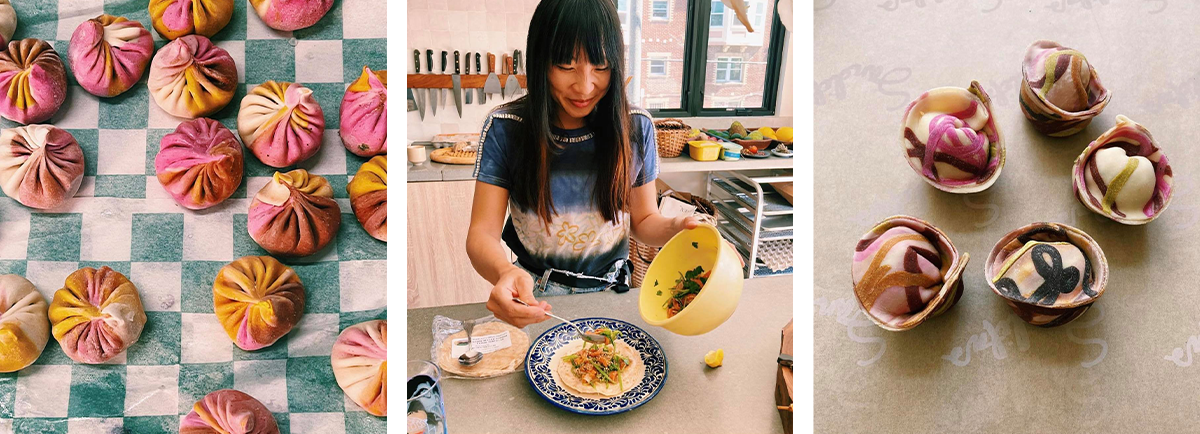By Kelly Franson, Slow Food Youth Network – USA

If there’s anyone who knows how to make food imitate art — no, scratch that — become art, it’s Sandy Ho, LA-based Australian chef and colorful flavor extraordinaire. Her signature rainbow dumplings bring a sense of whimsical nostalgia and joy, two emotions she wants guests to walk away feeling after attending one of her pop-up Sandita’s dinners. Ho’s life experiences are just as colorful as her dishes. We recently sat down with her to chat about her experiences entering the industry as an Asian female chef without culinary training and on building connections with people through food.
The following interview has been edited for length and clarity.
Let’s start with your background – what makes you “Sandy Ho” today?
Food has always been a huge labor of love within my family. I grew up in Australia as part of one of the few Vietnamese families among a lot of Lebanese and Greek families which all had a very colorful influence of flavor and culture.
I eventually went to art school. I didn’t realize it then, but I was missing something. The silence of art galleries made me miss the flavors, conversation, and proximity to people of cooking. I had been working in restaurants at the time, and one day I realized that’s where it felt like home.
I talk a lot about nostalgia and connecting to moments in life. I didn’t quit one thing just to start another. Being a chef is about learning and adopting your own foundation of experiences, community, and family.
 What are some barriers that young chefs face when entering the industry?
What are some barriers that young chefs face when entering the industry?
Not many people are able to carve out their passions easily – it’s a very fortunate thing to find your voice in something. Being female and Asian didn’t help me look the part. I wasn’t male, and none of the chef jackets fit me. A lot of my first impressions on people left them finding it hard to believe that I was a chef or worked in a restaurant. In hindsight, I’m proud of being able to stay true to my style.
How did you face some of these stereotypes?
From a very young age, I’ve always been outspoken about the things I believe in. I didn’t grow up with a lot of money, and I had to learn to work with what I had. In the world of cooking, there’s a lot of equipment involved – knives, tweezers, soup spoons… But a part of my style is knowing that you don’t need to have all the equipment. All you really need is hard work.
What drew you to hosting pop-ups instead of working at a restaurant?
Restaurants have to change – there’s a hierarchy and it doesn’t work in the way I want to with my staff and food purveyors. As a chef, I want a more intimate setting with the ability to talk with guests and convey more of the love and care that went into each dish.
On top of that, it’s not cheap when you think about all the staffing, equipment, and overhead investments required to open a restaurant. I’m hoping we pave a new way of sharing food whether that be through pop-ups, a marketplace, or even thinking about where our farmers are.
How do you want guests to walk away feeling after experiencing one of your dinners?
Joy – through the colors & patterns, and through the craftsmanship. It’s the joy of simple things like the perfectness of a grapefruit cut in half.
Nostalgia – through a dish like chicken soup which is universally healing. I look at menus in that light and am always thinking about family. The way that something is cooked often reminds them about something else, and I want to be able to capture that.
How have you seen food connect people? Any specific anecdotes?
At one point in my life I sailed around Europe with The Sailing Collective. We went south to Priorats, Spain where they grow bomba rice used for paella. I remember sitting with the rice farmer on his land, not really speaking the same language, but we were both showing each other our own ways of cooking rice. He cooked it with a bit of saffron, and I made a mushroom congee. It was incredibly inspiring that without any words we were able to exchange this knowledge.
 How does access to food look different in Europe?
How does access to food look different in Europe?
There’s a lot more connection to organic food and a lot of people are growing their food in their homes. Wealth and poverty play a role in accessibility, but it’s a sad reality that packaged and refined foods are still cheaper throughout the world. I have hope that a lot more people are engaged with their bodies and health and are curious about sustainable options.
What’s one small thing that people can do every day to feel more connected to the food they’re eating?
Keep it simple. Time is a luxury, but try to take time to learn about nutrient dense ingredients like mushrooms. Move away from things like packaged chips – they’re addictive! They aren’t nutrient dense and won’t bring you the same joy as cooking. Canned and frozen food shouldn’t be frowned upon – they’re accessible and affordable. Something like chickpeas would be great for having on hand for stews or mixing with olive oil into a fresh salad – feel free to get creative! Joyful food doesn’t just end at beautiful farmers market produce; it can also exist in home cooking even if it comes from canned and frozen food.
To learn more about Sandy and her work, you can visit her website here or follow her Instagram here (seriously, whenever her rainbow dumpling photos grace my feed, my day is MADE).
All photo credits to Sandy Ho.

